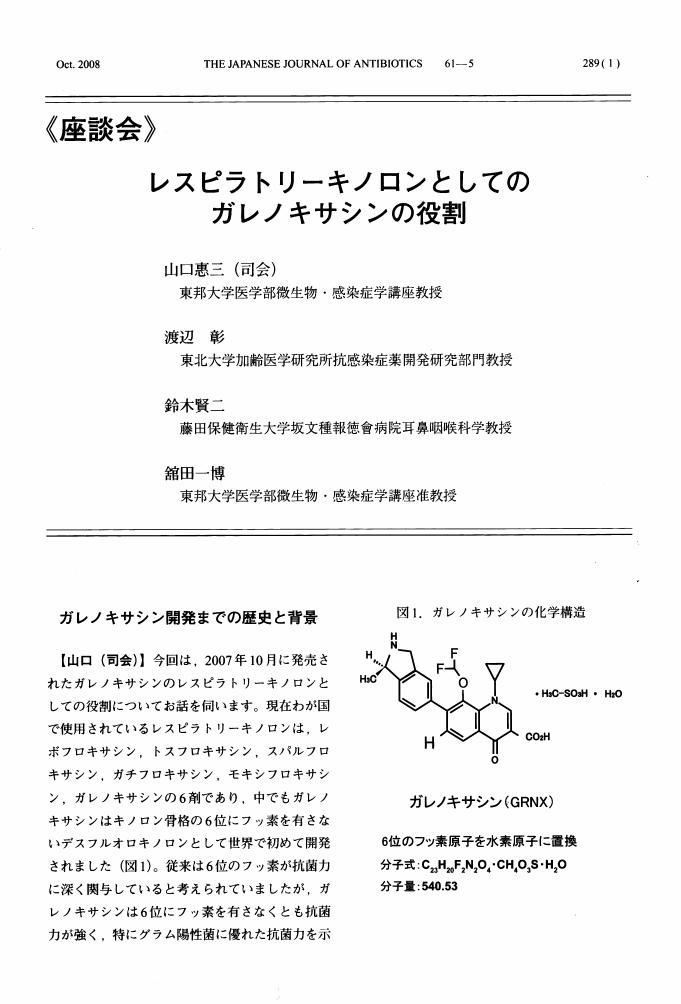2 0 0 0 OA 第6回耳鼻咽喉科領域感染症臨床分離菌全国サーベイランス結果報告
- 著者
- 鈴木 賢二 黒野 祐一 池田 勝久 保富 宗城 矢野 寿一
- 出版者
- 日本耳鼻咽喉科感染症・エアロゾル学会
- 雑誌
- 日本耳鼻咽喉科感染症・エアロゾル学会会誌 (ISSN:21880077)
- 巻号頁・発行日
- vol.8, no.3, pp.193-211, 2020-11-20 (Released:2020-11-20)
- 参考文献数
- 20
三学会合同抗菌薬感受性サーベイランス委員会の事業の一つとして行われた耳鼻咽喉科領域サーベイランスの結果とともに,我々が行ってきた過去のサーベイランスの成績と合わせて第6回耳鼻咽喉科領域感染症臨床分離菌全国サーベイランス結果として報告する.参加施設は,全国12大学の耳鼻咽喉科教室とその関連施設並びに開業医院の36施設で,対象患者は2015年12月から2017年6月までに参加施設を受診した急性中耳炎(6歳以下の小児のみ)および急性増悪を含む慢性中耳炎,急性副鼻腔炎および急性増悪を含む慢性副鼻腔炎,急性扁桃炎及び扁桃周囲膿瘍(20歳以上の成人のみ)の患者で,採取した検体は,患者背景調査票と共に北里大学抗感染症薬センターに郵送し,同所にて培養同定及び検出菌の薬剤感受性の一括測定を行った.検査対象菌種は経費削減も考慮し,グラム陽性菌,グラム陰性菌各3菌種ずつ,嫌気性菌4菌種群のみとした.肺炎球菌の莢膜型別も検討した.
1 0 0 0 OA 第5回耳鼻咽喉科領域感染症臨床分離菌全国サーベイランス結果報告
- 著者
- 鈴木 賢二 黒野 祐一 池田 勝久 渡辺 彰 花木 秀明
- 出版者
- 日本耳鼻咽喉科感染症・エアロゾル学会
- 雑誌
- 日本耳鼻咽喉科感染症・エアロゾル学会会誌 (ISSN:21880077)
- 巻号頁・発行日
- vol.3, no.1, pp.5-19, 2015-01-20 (Released:2020-10-27)
- 参考文献数
- 18
With the cooperation of the otorhinolaryngological departments at 29 universities in Japan, as well as their 26 affiliated hospitals and practitioners, we conducted the fifth national survey (The first survey conducted by The Japanese surveillance committee, consisting of the Japanese Society of Chemotherapy, Japanese Association for Infectious Disease, and Japanese Society for Clinical Microbiology) to investigate the trends of bacterial isolates and bacterial sensitivity in otorhinolaryngological major infections.The subjects comprised patients with acute purulent otitis media (185 cases), chronic otitis media (119 cases), acute sinusitis (128 cases), chronic sinusitis (92 cases), acute tonsillitis (116 cases), and peritonsillar abscess (89 cases) who presented to the medical institutions participating in the survey from January 2011 to June 2012. Using specimens obtained from the patients, bacteria were identified by culture and drug sensitivity was measured.S. pneumoniae and H. influenzae were mainly isolated from patients with acute purulent otitis media and acute sinusitis, and frequency of isolation of S. aureus was decreasing in the recent surveys. Streptococcus spp. (including S. pyogenes) was mainly isolated from patients with acute tonsillitis. Anaerobes (Peptostreptococcus spp., Prevotella spp. and Fusobacterium spp. etc.) were mainly isolated from patients with peritonsillar abscess, and frequencies of isolation of anaerobes in the recent surveys were markedly higher than observed in the former surveys.Among 112 strains of S. aureus isolated in the present survey, 28 (25.9%) were MRSA. Among 113 strains of S. pneumoniae isolated, 41 (36.8%) were PISP and 14 (12.3%) were PRSP. Among 106 strains of H. influenzae isolated, 38 (35.8%) were BLNAR, and 16 (15.1%) each were BLPAR and BLNAI, respectively. Frequency of isolation of these drug resistant bacteria was higher in patients aged 5 years or younger than in other age groups. Compared with the result of the previous surveys, frequencies of isolation of MRSA, resistant S. pneumoniae (PISP and PRSP), resistant H. influenzae (mainly BLNAR), and ABPC resistant M. catarrhalis are increasing recently.It is considered necessary to take measures to promote the appropriate use of antibiotics in order to prevent the increase of resistant bacteria.
1 0 0 0 OA 鼻アレルギーに対する麻黄附子細辛湯の薬効評価
- 著者
- 伊藤 博隆 馬場 駿吉 高木 一平 大屋 靖彦 横田 明 伊藤 弘美 稲垣 光昭 小山 賢吾 北條 郷明 丸尾 猛 東内 朗 杉山 和子 河合 〓 森部 一穂 鈴木 賢二 柘植 勇人 板谷 純孝 鈴木 康夫
- 出版者
- 耳鼻咽喉科臨床学会
- 雑誌
- 耳鼻咽喉科臨床 補冊 (ISSN:09121870)
- 巻号頁・発行日
- vol.1991, no.Supplement52, pp.107-118, 1991-12-25 (Released:2012-11-27)
- 参考文献数
- 17
- 被引用文献数
- 1 1
Mao-bushi-saishin-to extract capsules (6 caps. /day) were administered orally to 61 perennial nasal allergy patients presenting with nasal obstruction for 4 consecutive weeks to assess the overall efficacy, safety and utility of the drug. In the doctor's evaluation, the overall efficacy rate covering excellent and good responses was 38.3% at week 2 of treatment and 54.7% at week 4 of treatment. The utility rate covering useful and higher ratings was 60.7%.Nasal symptoms, viz, sneezing attack, nasal discharge, nasal obstruction, dysosmia and interference with daily living were all improved. Nasal obstruction, in particular, disappeared in many cases, thus generating a high improvement rate. Nasal mucosal findings, viz, swelling of inferior turbinal mucosa, watery secretion in nasal cavity, and nasal discharge eosinophil count showed good improvements.The time course of each nasal symptom i n terms of the average score according to allergy diaries, revealed significant reduction in nasal obstruction, dysosmia and interference with daily life in severity at and after week 2 and sneezing and nasal discharge were significantly alleviated at week 4 as compared with the findings obtained during the baseline period.As side effects, headache was reported in one case and stomachache in one case. These symptoms were relieved after discontinuation of treatment.
1 0 0 0 OA 耳鼻咽喉科疾患と性感染症
- 著者
- 司会:鈴木 賢二 演者:余田 敬子
- 出版者
- 一般社団法人 日本耳鼻咽喉科学会
- 雑誌
- 日本耳鼻咽喉科学会会報 (ISSN:00306622)
- 巻号頁・発行日
- vol.117, no.4, pp.425-427, 2014-04-20 (Released:2014-06-06)
1 0 0 0 OA レスピラトリーキノロンとしてのガレノキサシンの役割
- 著者
- 山口 恵三 渡辺 彰 鈴木 賢二 舘田 一博
- 出版者
- 公益財団法人 日本感染症医薬品協会
- 雑誌
- The Japanese Journal of Antibiotics (ISSN:03682781)
- 巻号頁・発行日
- vol.61, no.5, pp.289-302, 2008-10-25 (Released:2013-05-17)

